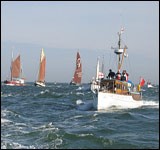'Little Ships' in reenactment of Dunkirk sail the English Channel
by Sail-World Cruising on 28 May 2010

Dunkirk sailing boats taking part in reenactment SW
On the 26th May, 1940, a fleet of small boats, sailing boats, pleasure cruisers, fishing boats, anything that could float, was called to save thousand of British soldiers trapped on the wrong side of the English Channel. Every five years this amazing rescue is reenacted, and a fleet of 'Little Ships' that took part in the Dunkirk evacuations gathered this week in Ramsgate ahead of the 70th anniversary of the event.
The fleet of small craft assisted naval vessels in the evacuation of about 300,000 Allied troops from the French coast.
Ramsgate's Royal Harbour Marina was the reception centre for returning troops.
The small craft sailed this week escorted by the Royal Navy's HMS Monmouth and Ramsgate's RNLI lifeboat. And the 'Little Ships' are some of those that actually took part in the May 1940 evacuation.
Robert Brown, the assistant harbour master, said: 'The Dunkirk Little Ships only return to Ramsgate once every five years and they are a wonderful sight to see.
'It's a rare opportunity to see first hand some of the boats that played such a vital role during one of the most important operations of World War II. '
Leading the 'Little Ships' in the re-enactment was Thamesa, a 45ft motor yacht. She formed part of the original flotilla and was skippered then by boat builder Douglas Tough. Mr Tough was instrumental in rounding up numerous Thames river-cruisers to help in the evacuation. His grandson, John, is skippering the boat this time.
A ceremony will be held in Dunkirk to mark the event, and the ships will make their return journey on Monday.
Operation Dynamo:
Known as Operation Dynamo, the Dunkirk evacuation was an attempt to save Britain's Army from what looked like total defeat.
Nearly 400,000 soldiers had been fighting the Germans in Northern France and Belgium. They were young, inexperienced and under-equipped. Within a few months they were completely overwhelmed by Hitler's smaller but more organised army. The German Panzer Divisions pushed the British back through Belgium and into France. By late May 1940, almost the entire British Army was cornered and trapped along the beaches surrounding the small French fishing town of Dunkirk.
Winston Churchill had been prime minister for just three weeks when he launched Operation Dynamo on May 26.
Anyone with a boat was asked to take part, set sail to Dunkirk and into the sights of German artillery.
The hope was that some 45,000 of the 400,000 men would be rescued. Astonishingly, 338,226 men landed safely on Britain's south coast between May 26 and June 5.
Had the Dunkirk evacuation failed, Britain would almost certainly have surrendered and brokered a peace deal. Germany would have won the war.
Reflecting on the event later, Mr Churchill described it as: 'A miracle of deliverance, achieved by valour, by perseverance, by perfect discipline, by faultless service, by resource, by skill, by unconquerable fidelity.'
..........................................
Letter from Reader:
Sender: Ivan Hills
Message: The account of how 'Dunkirk' happened is a bit idiotic. The fundemental cause was the French collapse -- leaving the British right-flank open. Closing it and holding it was achieved, despite the Panzers. This allowed the evacuation which included a lot of French soldiers, too. I was just past my 12th birthday and living in Sussex about 40 miles from the coast. We could hear the guns distantly. An aunt and two girl cousins were with us and their father, a REME staff-sergeant, was over there. Then the phone rang and uncle Bill called for about one minute to say he had landed in Dover.
Two years later, in the 7th Barking Seascouts and ten years later in the Little Ship Club (London) I met civilian sailors who went to Dunkirk and helped bring the troops off. Am still a member of Little Ship Club. They earned the right to fly the Blue Ensign for service to the Royal Navy in WW-2.
.....................................
If you want to link to this article then please use this URL: www.sail-world.com/70047